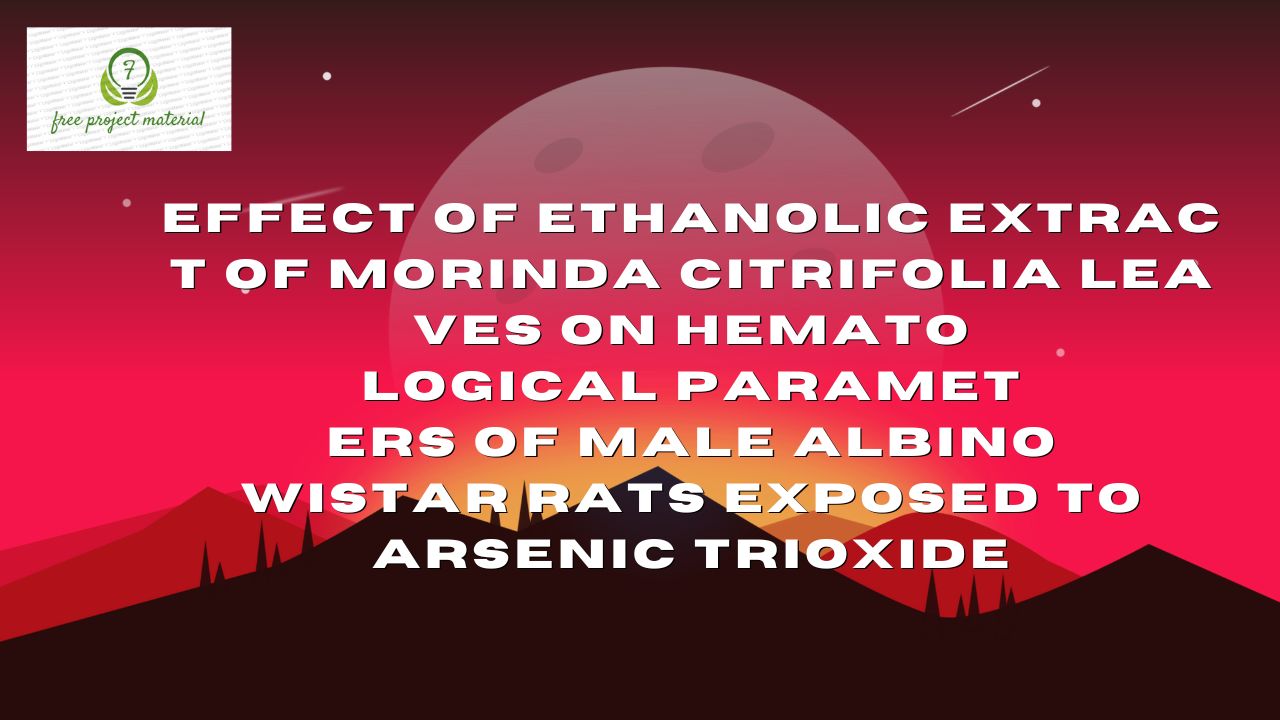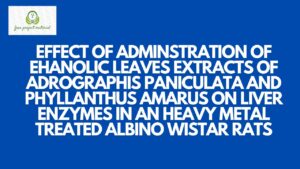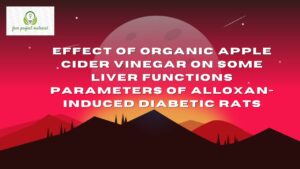ABSTRACT
The aim of this study was to examine the effect of ethanolic extract of Morinda citrifolia on the hematological parameter (RBC, PLT, HB, PCV and MCHC) of male albino wistar rats exposed to arsenic trioxide. The animals were randomly assigned into five groups of four (4) rats each. Groups 1 served as the normal control which was given only normal rat chow and distilled water, group 2 served as the negative control and was treated with 25% of LD50 of arsenic trioxide which was 3.65kg, normal rat feed and distilled water, groups 3, 4 and 5 were given 100 mg/kg bw, 200 mg/kg bw and 300 mg/kg of the ethanolic leaves extract of Morinda citrifolia with concomitant exposure to arsenic trioxide, normal rat chow and distilled water. The result revealed a significant reduction (P<0.05) of RBC, HB and PCV of group 4 treated with 200 mg/kg bw of the extracts when compared to the control. while there was no significant difference between the other treatment groups and the control. this result indicates that the effectiveness of the extracts is dose sensitive and could show some level of toxicity on consumption. Therefore it is recommended that the antinutritional factors of the plant be determined and higher dosage could also be used to ascertain its efficacy on altered hematological indices.
Keywords: Morinda citrifolia, haematological, toxicity, antinutritional factor.
TABLE OF CONTENTS
Title page – – – – – – – – i
Certification – – – – – – – ii
Dedication – – – – – – – – iii
Acknowledgements – – – – – – iv
Abstract – – – – – – – – v
Table of contents – – – – – – – vi
List of tables – – – – – – – ix
List of Figures – – – – – – – x
List of Plates – – – – – – – xi
CHAPTER ONE: INTRODUCTION
1.1 Background of the Study – – – – – – 1
1.2 Aim and Objectives of the study – – – – 3
1.2.1 Aim – – – – – – – – – 3
1.2.2 Objectives – – – – – – – – 3
1.3 Significance of the study – – – – – – 4
1.4 Scope and Limitation of the study – – – – 5
1.5 Definition of Related terms – – – – – 5
1.6 Abbreviation – – – – – – – 5
CHAPTER TWO: LITERATURE REVIEW
2.1 Botanical classification of Morinda citrifolia – – – 6
2.2 Description and Distribution of the plant – – – 8
2.3 Phytochemistry of the plant – – – – – 9
2.4 Uses of the plant – – – – – – 10
2.4.1 Food uses – – – – – – – 10
2.4.2 Traditional medicine – – – – – 11
2.5 Pharmacological activities of the plant – – – 11
2.6 Heavy metals and their toxicity – – – – 13
2.7 Arsenic trioxide – – – – – – 14
2.8 Absorption and distribution of arsenic in the body – 15
2.9 Mechanism of arsenic toxicity – – – – 17
2.10 Clinical implication of arsenic toxicity – – 19
2.11 Treatment of arsenic toxicity – – – – 21
2.12 Haematological parameters – – – – 24
CHAPTER THREE: MATERIALS AND METHOD
3.1 Materials – – – – – – – 31
3.2 Collection and Preparation of Leaf Sample – – 32
3.2.1 Collection of plant sample – – – – 32
3.2.2 Preparation of plant sample – – – – 33
3.3 Preparation of Heavy metal – – – – 33
3.4 Experimental Design, grouping and treatment of animals – 34
3.5 Collection of blood sample – – – – 35
3.6 Determination of Haematological Parameters – 36
3.6.1 Determination of Haemoglobin Concentration
in Whole blood – – – – – – 36
3.6.2 Determination of Red Blood Cell – – – 37
3.6.3 Platelet – – – – – – – 38
3.6.4 Packed Celled Volume – – – – – 38
3.6.5 Mean Cell Haemoglobin Concentration – – 39
3.7 Statistical Analysis – – – – – – 39
CHAPTER FOUR: RESULT AND DISCUSSION
4.1 Morphology and physiology of the rats – – 40
4.2 Results – – – – – – – 41
4.3 Discussion – – – – – – – 44
CHAPTER FIVE: CONCLUSION AND RECOMMENDATION
5.2 Conclusion – – – – – – – 50
5.3 Recommendation – – – – – – 51
References
LIST OF TABLES
Table 1: Result of the effect of ethanolic extracts of Morinda citrifolia leave on the hematological parameters of albino wistar rats exposed to arsenic trioxide. – – – – – – – – – 41
LIST OF FIGURES
Figure 1: Bar chart showing the results of the effect of ethanolic extract of Morinda citrifolia leaves on hematological parameters of albino wistar rats exposed to arsenic trioxide – – – – – – 42
LIST OF PLATES
Plate 1: Morinda citrifolia Plant – – – – – 7
CHAPTER ONE: INTRODUCTION
1.1 Background of the Study
Medicinal plant contain substance that can be used for therapeutic purpose or which are precursors for the synthesis of useful drugs. Plants are naturally gifted at the synthesis of medicinal compound, whose characterization has led to discovering of new cheap drugs with high therapeutic potential. In recent years, there has been a growing interest in identifying naturally occurring minor dietary constituents against the development of several diseases. Plant derived food stuffs, particularly fruits and vegetables are generally considered to be highly beneficial components of the human diet (Calixto and Siqueira, 2008).
Morinda citrifolia L. (noni) is an evergreen or small tree that grow in many ropical region of the world. The fruit of this tree has a history of use in the pharmacopoeias of pacific Islanders and Southeast Asia. In the past decade, the global popularity of noni fruit juice has increased dramatically (MaClatchey, 2002), while there are several publication describing various potential health benefits of noni fruit (Wang et al., 2002), the leaf extract has not been so studied.
The M. citrifolia leaf extract has shown pharmacological properties. Leaves of M. citrifolia showed good in vitro anthelmintic activity against human ascaris lumbricoides, leaf methanol extract has potential antibacterial activities to both gram positive S. aureus and methicillin resistant S. aureus (Norazah A, Zaklah I, 2005) wound healing activity of ethanolic extract of M. citrifolia was observed in rat using excision and dead space wound models (Nayak et al., 2009). Anti-inflammatory and analgesic effects were observed with M. citrifolia leaf extract used in this study.
Haematological parameter are good indicators of physiological status of pram animals (Chineke, 2006). The commonly used haemological parameter are crythrocyte. Red blood cells. Platelet, Hemoglobim, pack cell volume. A healthy individual has 12-20 grams of haemoglobin in very 100ml of blood. In mammals, the protein makes up about 96% of the red blood cell day content (by weight), and around 35% of total content (including water). Haemoglobin is involved in the transport of other gases. It carries some of the body respiratory carbon dioxide (about 20-25% of the total). Red blood cells, corpuses (in other animals not heavy nucleus in red blood cells), heamatides, erythnoid cell and the invertebrate’s principle means of delivery oxygen to the body tissue via blood flow through the circulatory system.
1.2 Aim and Objectives of the study
1.2.1 Aim
The aim of this study was to assess the effect of ethanolic extract of Morindia citrifolia leaves on arsenic trioxide.
1.2.2 Objective: The objectives of this study were specifically on the following;
- To determine the effect of ethanolic extract of Morinda citrifolia leaves on the Red Blood Cell (RBC) level of male albino wistar rats exposed to arsenic trioxide.
- To determine the effect of ethanolic extract of Morinda citrifolia leaves on the PLT level of male albino wistar rat exposed to arsenic trioxide.
- To determine the effect of ethanolic extract of Morinda citrufolia leaves on the Hb level of male albino wistar rat exposed to arsenic trioxide
- To assess the effect of ethanolic extract of Morinda citrifolia leaves on PCV level of male albino wistar rat exposed to arsenic trioxide.
- To assess the effect of ethanolic extract of Morinda citrifolia leaves on the MCHC level of male albino wistar rat exposed to arsenic trioxide.
- To determined the effect of arsenic trioxide on the hematological parameters of male albino wistar rats.
1.3 Significance of the Study
The study is significantly important to,
- Traditional medicine practitioners as the knowledge from the research work could be employed in the treatment of various ailments.
- Pharmaceutical industries as they could also benefit from this study if the result will enable them in the improvement of drugs and in the production of new drugs.
- Nutritionist could also benefit from this study as the result could be used in the upgrading of their diet so as to tackle some deficiencies of diseases.
1.4 Scope and Limitation of the Study
The scope of this study was to investigate the effect of ethanolic extract of Morinda citrifolia leaves on hematological parameters RBC, PLT, HB, PCV, MCHC, MCH of male albino wistar rats exposed to arsenic trioxide.
1.5 Definition of Related Terms
Medicinal plants, there are plants when contain compounds that either posses therapeutic purposes or serves as precursors for the synthesis of useful drugs (Muthubalaji et al., 2012).
There are crops which exerts beneficial pharmacological effect on human or animal bodies to treat or prevent specific disease on living organisms.
Phytochemicals; these are naturally occurring non-nutritive chemicals (secondary metabolites) that are responsible for the protective health effect of the plant-based beyond the vitamin or mineral benefits of the plant.
1.6 Abbreviation
RBC – Red Blood Cell
PLT – Platelet
HB – Hemoglobin
PVC – Pack Cell Volume
MCHC – Mean Cell Haemoglobin Concentration
BAL – British antilewisite
ATP – Adenosine triphosphate
MMA – Methanearsonic acid
DMA – Dimethylarsinic acid
FDA – Food and Drug Administration
ROS – Reactive Oxygen Species
ADP – Adenosine diphosphate
LDL – Low density lipoprotein
cAMP – Cyclic Adenosine monophosphate
DNA – Deoxyribonucleic acid
KCN – Potassium Cyanide


